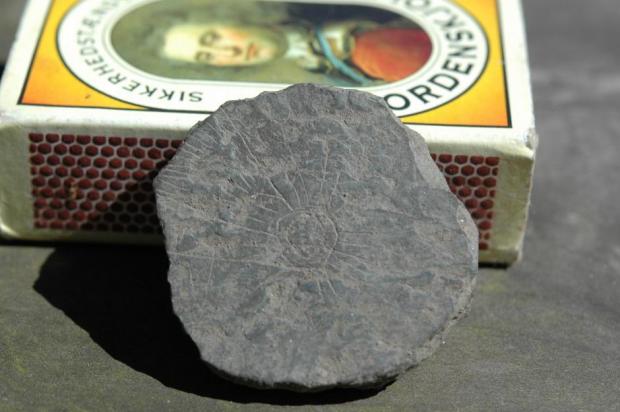The small stones were covered in motifs carved by Stone Age people some 5,000 years ago, writes ScienceNordic.
The stones could give new insight into life in the Stone Age, researchers say.
A large number of the approximately 300 stones and fragments have been dubbed sun stones, due to their round shape and the circular carvings on their surface, which appear to radiate out from the centre. They also found square stones carved with something that resembles fields and grain, and other pieces carved with patterns. A handful are decorated with spider webs.
The latter are an entirely new discovery, and scientists do not yet know what they were used for.
Were they a religious coinage? Amulets? Or were they used to mark the transition from an old burial tradition to a new one? Or was it something else entirely?
“That is the million dollar question. We see sun motifs in other places, but the square-shaped stones with farming symbols are especially strange. It’s impossible to know precisely what they were used for,” said Lars Larsson, professor emeritus at the University of Lund, speaking to ScienceNordic.
READ MORE from ScienceNordic: Scandinavia’s oldest cup mark rock carvings discovered on Bornholm
The stones were found in southern Bornholm at a place called Vasagård. This was a gigantic area divided into two by a river valley, and looks to have been used for rituals during the Stone Age.
Archaeologists think that the stones were probably used during the rituals, given their burnt or broken appearance, and because they were discovered in concentrated deposits within the same layer of soil.
Some of the stones even look to have been used as lucky charms by Stone Age Bornholmers.
“Many of the sun stones and one of the field stones are very worn, so it looks as though someone has run around with them in their pocket,” said Finn Ole Sonne Nielsen, lead archaeologist at the Bornholm Museum, who has collaborated with the National Museum of Denmark, Aarhus University, and the University of Copenhagen on the excavation.
READ MORE from ScienceNordic: Did Stone Age people build a large labyrinth in Denmark?
The Vasagård area exhibits the appearance of a Stone Age society that had been “thoroughly ritualised,” Nielsen said.
In the Stone Age, Vasagård was entirely enclosed by so-called palisade rows—a type of fence constructed from multiple layers of posts, with many entrances. Inside, stood small round “sun temples” which were probably used for rituals.
The construction has been renewed time and time again, and many tons of wood must have been used to maintain the gigantic monument. An “absolutely important” construction project, according to Nielsen.
“When you use so many resources on something, it must have something to do with religion,” he said.
READ MORE from ScienceNordic: Ancient Roman artefact found on Danish island
The first sun stone was found in 1995 at another cultural site, Rispebjerg, around eight kilometres east of Vasagård. But in the meantime, Vasagård has far exceeded its sister-site in terms of the number of these strange stones.
“We’ve known about sun stones for a while, but the field stones are something entirely new—just yesterday we found four—and the variation among them with spider webs is something we didn’t know existed. It gives us a new insight into life in the Stone Age,” said Nielsen.
But saying they were used in rituals doesn’t tell us much, according to Larsson.
“But it must mean something that they were deposited simultaneously after being burnt and broken. Perhaps it represents a transition between life and death,” he said.
Fire was very important for Stone Age people, who burnt many items, such as axes or animal bones. The fire didn’t represent destruction but a transition, the professor continued.
“A transition to the beyond is perhaps a way to bring objects from our world into the other world. We don’t know how the connection worked, but it has something to do with the gods or ancestors,” he said.
Stone Age people probably had an entirely different relationship to death and their ancestors than we do today, and death was considered as a natural part of life, he added.
READ MORE from ScienceNordic: Items lost in the Stone Age are found in melting glaciers
The sun stones and field stones most likely were located close to each other because they were used in the same ritual.
In a 2016 study, archaeologist Flemming Kaul from the National Museum of Denmark explained why the square stones with corresponding square motifs depicts fields.
On many of the stones, there is something illustrated alongside the fields that resembles a plant covered with some kind of shade. Kaul interprets it as a form of protection for grain in the field.
He thought that the stone could be used in a form of ritual around harvest time or the solstices.
“I imagine that at a certain time of the year you had some magic rituals where you held a sun stone and let them pass over the stones, which by all accounts depict fields. The new stone opens up an entirely different understanding of the Stone Age worship of deities,” Kaul said.
This article was originally published by ScienceNordic
READ ALSO: Who were the first Scandinavians? Ancient DNA sheds light on mysterious origins



 Please whitelist us to continue reading.
Please whitelist us to continue reading.